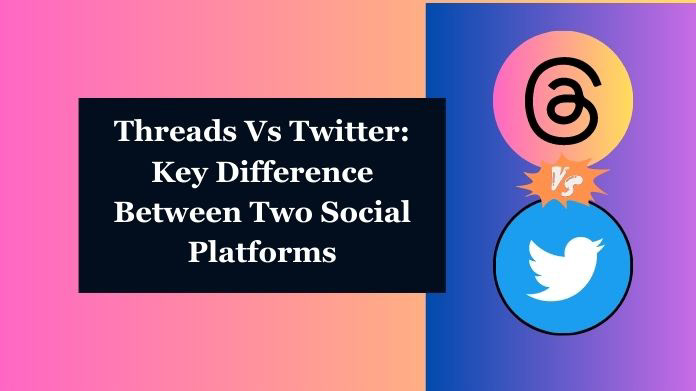Threads Vs Twitter: Key Difference Between Two Social Platforms
Curious about the disparities between Threads and Twitter? If you're unsure, you've landed in the perfect spot.
Threads, the latest addition to the social media scene, sets itself apart from newer platforms like Clubhouse by being tightly integrated with Instagram.

While the Meta-owned platform was primarily designed for photo sharing, Threads, as its name implies, focuses on text-based messaging.
With its microblogging nature, Threads shares many similarities with Twitter, creating a familiar user experience.
Join us as we explore and unveil the dissimilarities between these two social platforms.
Threads: A Closer Look

Threads is a text-based conversation app developed by Instagram. It lets users have private, focused conversations with their close friends on the platform.
With Threads, users can easily share photos, videos, messages, and even their current status with a select group of people.
One of the notable features of the Threads app is the Threads Viewer, which enables users to watch videos from threads even in offline mode, ensuring an uninterrupted viewing experience.
Features of Threads
1. Group-oriented Discussions -
One of the defining aspects of Threads is its focus on group-oriented discussions.
Users can join or create communities dedicated to specific subjects like technology, sports, fashion, or cooking.
This allows like-minded individuals to come together, share knowledge, and engage in vibrant conversations within their chosen niche.
2. Threaded Conversations -
As the name suggests, Threads organizes conversations into threads, creating a coherent flow of dialogue within a topic.
This threading feature enables users to follow discussions more easily, providing a structured and organized environment for interaction.
3. Privacy and Personalization -
Threads place a strong emphasis on privacy and personalization.
Users have the ability to control the visibility of their posts, choose who can join their communities, and tailor their feeds according to their preferences.
This level of customization ensures that users have a more personalized and curated experience.
Twitter: Unveiling Its Uniqueness

Twitter is a free social networking site for sharing short posts called tweets, including text, videos, photos, or links.
Users require an internet connection or smartphone to access the Twitter app or website.
It serves as a microblogging service where registered users can post, share, like, and reply to tweets with brief messages, while non-registered users can only read tweets.
Key Features of Twitter
1. Microblogging and Character Limit -
Microblogging is at the core of Twitter's functionality.
The platform restricts users to a character limit of 280 characters per tweet, promoting concise communication.
This brevity enables users to share their thoughts, news, or ideas in a quick and easily digestible format.
2. Follower-Focused Interactions -
Twitter emphasizes follower-focused interactions.
Users can follow accounts that interest them, and their home feed displays a chronological stream of tweets from those they follow.
This design encourages users to build a network, stay updated on their interests, and engage in conversations with a broader audience.
3. Hashtags and Trending Topics -
Hashtags play a significant role on Twitter, serving as a categorization and discovery tool.
Users can include relevant hashtags in their tweets, making them part of broader conversations and trends.
Twitter's "Trending Topics" feature highlights popular hashtags and subjects currently being discussed on the platform, providing users real-time insights into global or local events.
What are the differences between these two social platforms?

1. Purpose and Focus -
The fundamental difference between Threads and Twitter lies in their purpose and focus.
Threads are centered around fostering in-depth conversations within specific communities, while Twitter is geared towards quick and concise sharing of information, opinions, and news updates.
2. Content Format -
Another notable distinction is the content format each platform supports.
Threads encourage users to engage in threaded discussions, ideal for longer and more elaborate exchanges.
On the other hand, Twitter thrives on brevity, enabling users to share bite-sized updates and thoughts within the character limit.
3. Audience and Reach -
Threads and Twitter also differ in terms of their target audience and reach.
Threads cater to individuals seeking niche communities and specialized discussions, appealing to those with a particular interest or expertise.
With its vast user base, Twitter offers a broader reach and attracts users looking for real-time updates, news, and a diverse range of content.
4. Privacy and Visibility -
Privacy and visibility settings vary between Threads and Twitter.
Threads give users more control over who can join their communities and access their posts, offering a more intimate and tailored experience.
Twitter, by default, promotes public interactions, with users' tweets being visible to anyone unless specifically set to private.
Threads Vs Twitter: Which one should you choose?
Both threads and Twitter can be handy for creating social connections and sharing information. The choice between the two depends entirely on your specific needs and preferences.
If you're looking for a sophisticated conversation tool integrated with a meta that allows you to express your creative thoughts and insights, Threads is your best bet. It offers a platform to create and engage in meaningful discussions, staying up-to-date with the latest trends and ideas.
On the other hand, if you're interested in a platform like Twitter that allows you to create and share posts while connecting with a community, then Twitter is a great option.
Ultimately, it's all about what you're looking for and what suits your communication style. Both platforms offer unique features and advantages, so it's worth exploring them to see which resonates with you the most.
End Note
Social media engagement takes on different forms with Threads and Twitter.
Threads stand out by focusing on community-building, fostering meaningful conversations, connecting individuals with similar interests, and creating an inclusive sense of belonging.
On the other hand, Twitter thrives on its ability to provide real-time updates, facilitate quick information sharing, and encourage participation in global conversations.


